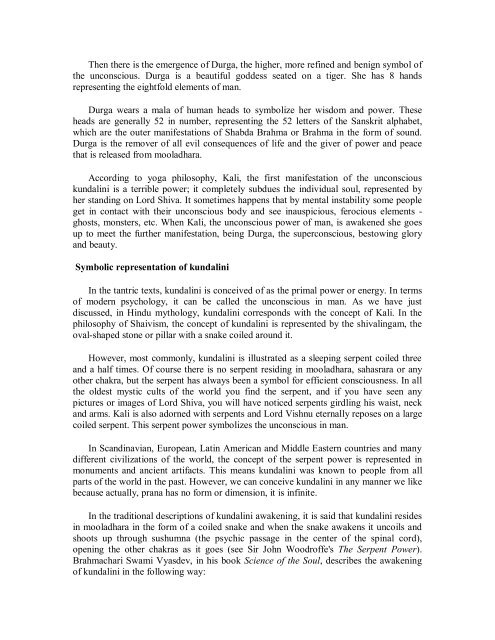Kundalini.Tantra.by.Satyananda.Saraswati
You also want an ePaper? Increase the reach of your titles
YUMPU automatically turns print PDFs into web optimized ePapers that Google loves.
Then there is the emergence of Durga, the higher, more refined and benign symbol of<br />
the unconscious. Durga is a beautiful goddess seated on a tiger. She has 8 hands<br />
representing the eightfold elements of man.<br />
Durga wears a mala of human heads to symbolize her wisdom and power. These<br />
heads are generally 52 in number, representing the 52 letters of the Sanskrit alphabet,<br />
which are the outer manifestations of Shabda Brahma or Brahma in the form of sound.<br />
Durga is the remover of all evil consequences of life and the giver of power and peace<br />
that is released from mooladhara.<br />
According to yoga philosophy, Kali, the first manifestation of the unconscious<br />
kundalini is a terrible power; it completely subdues the individual soul, represented <strong>by</strong><br />
her standing on Lord Shiva. It sometimes happens that <strong>by</strong> mental instability some people<br />
get in contact with their unconscious body and see inauspicious, ferocious elements -<br />
ghosts, monsters, etc. When Kali, the unconscious power of man, is awakened she goes<br />
up to meet the further manifestation, being Durga, the superconscious, bestowing glory<br />
and beauty.<br />
Symbolic representation of kundalini<br />
In the tantric texts, kundalini is conceived of as the primal power or energy. In terms<br />
of modern psychology, it can be called the unconscious in man. As we have just<br />
discussed, in Hindu mythology, kundalini corresponds with the concept of Kali. In the<br />
philosophy of Shaivism, the concept of kundalini is represented <strong>by</strong> the shivalingam, the<br />
oval-shaped stone or pillar with a snake coiled around it.<br />
However, most commonly, kundalini is illustrated as a sleeping serpent coiled three<br />
and a half times. Of course there is no serpent residing in mooladhara, sahasrara or any<br />
other chakra, but the serpent has always been a symbol for efficient consciousness. In all<br />
the oldest mystic cults of the world you find the serpent, and if you have seen any<br />
pictures or images of Lord Shiva, you will have noticed serpents girdling his waist, neck<br />
and arms. Kali is also adorned with serpents and Lord Vishnu eternally reposes on a large<br />
coiled serpent. This serpent power symbolizes the unconscious in man.<br />
In Scandinavian, European, Latin American and Middle Eastern countries and many<br />
different civilizations of the world, the concept of the serpent power is represented in<br />
monuments and ancient artifacts. This means kundalini was known to people from all<br />
parts of the world in the past. However, we can conceive kundalini in any manner we like<br />
because actually, prana has no form or dimension, it is infinite.<br />
In the traditional descriptions of kundalini awakening, it is said that kundalini resides<br />
in mooladhara in the form of a coiled snake and when the snake awakens it uncoils and<br />
shoots up through sushumna (the psychic passage in the center of the spinal cord),<br />
opening the other chakras as it goes (see Sir John Woodroffe's The Serpent Power).<br />
Brahmachari Swami Vyasdev, in his book Science of the Soul, describes the awakening<br />
of kundalini in the following way:














![[Lonely Planet] Sri Lanka](https://img.yumpu.com/59845622/1/169x260/lonely-planet-sri-lanka.jpg?quality=85)


